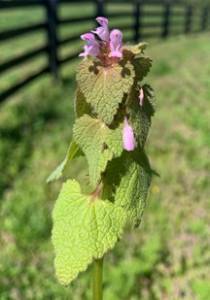Question
I have a proliferation of purple deadnettle in my paddocks this spring. I watched as the horses grazed, and at least one nibbled at the weed but then moved on. Will it hurt them if they eat it?
Answer
Purple deadnettle (Lamium purpureum) is no stranger to pasturelands, roadsides, lawns, and gardens. As the photograph shows, this winter annual features bright pinkish-purple flowers and serrated, spade-shaped leaves. Those leaves nearest the flowers often have a purple cast but will turn green as they mature. The stem is square—you’ll feel it if you roll the stem gently between your thumb and index finger.
Purple deadnettle emerges in late March and early April in the Northern Hemisphere, preferring the lack of competition from other plants at this time of year. By late spring, however, the plants wither away, only to reemerge in the autumn when, once again, competition for resources is less intense.
In terms of toxicity, there is no worry on that front to either horses or humans. In fact, young plants are often tossed in spring-mix salads. As you observed, horses don’t seem to have a great appetite for deadnettle but may eat more of it if other, more palatable plants are scarce.
The occasional patch of deadnettle in a large grazing area should not raise concern. If the area is largely carpeted with these plants, however, pasture renovation might be in order, only because it may signal a shortage of good-quality forage. A specialist from a university or feed store can help you decide how best to improve pastures, including weed-management plans.

Seemingly ubiquitous during early spring in some areas, the purple deadnettle (Lamium purpureum) is not toxic to horses. The overwhelming presence of purple deadnettle in any grazing area indicates that a pasture makeover—including weed control, reseeding, and fertilization—could bolster the pasture’s nutritional value. This may or may not be important to owners, depending on the forage needs and metabolic status of the horses grazing the paddocks or pastures. For those horse owners that rely on pasture to satisfy energy requirements of their horses, an effort should be made to modify the grazing area so more good-quality forage is available. Seek professional help when upgrading forage stands. A local expert will be well acquainted with pasture plants that prosper in your region.
USDA Plants Profile. Lamium purpureum. Accessed 1 April 2020.
Brown, D. 2016. Purple deadnettle and henbit: Two common garden spring weeds. Michigan State University. Accessed 1 April 2020.
Steckel, L. Purple deadnettle and henbit. University of Tennessee. Accessed 1 April 2020.








